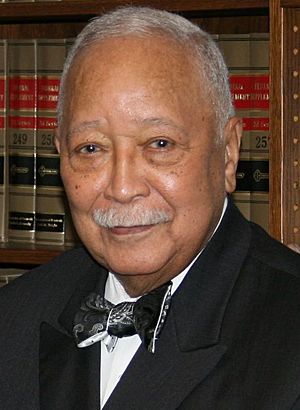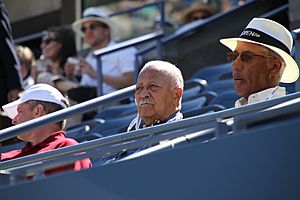David Dinkins facts for kids
Quick facts for kids
David Dinkins
|
|
|---|---|

Dinkins in 2014
|
|
| 106th Mayor of New York City | |
| In office January 1, 1990 – December 31, 1993 |
|
| Preceded by | Ed Koch |
| Succeeded by | Rudy Giuliani |
| 23rd Borough President of Manhattan | |
| In office January 1, 1986 – December 31, 1989 |
|
| Preceded by | Andrew Stein |
| Succeeded by | Ruth Messinger |
| Member of the New York State Assembly from the 78th district |
|
| In office 1966 |
|
| Preceded by | Constituency established |
| Succeeded by | Edward A. Stevenson Sr. |
| Personal details | |
| Born |
David Norman Dinkins
July 10, 1927 Trenton, New Jersey, U.S. |
| Died | November 23, 2020 (aged 93) New York City, U.S. |
| Political party | Democratic |
| Spouse |
Joyce Burrows
(m. 1953; died 2020) |
| Children | 2 |
| Education | Howard University (BS) Brooklyn Law School (LLB) |
| Military service | |
| Allegiance | |
| Branch/service | |
| Years of service | 1945–1946 |
David Norman Dinkins (born July 10, 1927 – died November 23, 2020) was an American politician and lawyer. He served as the 106th Mayor of New York City from 1990 to 1993. He was the first African American to become mayor of New York City.
Before becoming a politician, Dinkins was one of the first African-American U.S. Marines, known as Montford Point Marines. He served in the Marines from 1945 to 1946. He studied at Howard University and then earned his law degree from Brooklyn Law School in 1956.
Dinkins started his political career in the New York State Assembly in 1966. Later, he became the Borough President of Manhattan before being elected mayor. After his time as mayor, he taught at Columbia University and stayed involved in city politics.
Contents
Early Life and Education
David Dinkins was born in Trenton, New Jersey. His mother, Sarah Lucy Dinkins, was a domestic worker. His father, William Harvey Dinkins Jr., was a barber and real estate agent. His parents separated when he was six, and his father raised him.
Dinkins moved to Harlem as a child but later returned to Trenton. He finished high school at Trenton Central High School in 1945. After graduating, he tried to join the United States Marine Corps. He was told there was a limit on how many African Americans could join.
He kept looking for a recruiting station that would accept him. He finally found one, but World War II ended before he finished his training. He served in the Marine Corps from July 1945 to August 1946. He reached the rank of private first class. Dinkins and other Montford Point Marines later received the Congressional Gold Medal for their service.
Dinkins graduated with honors from Howard University in 1950. He earned a bachelor's degree in mathematics. In 1956, he received his law degree from Brooklyn Law School.
Political Career
Starting in Politics
From 1956 to 1975, Dinkins worked as a lawyer. During this time, he also became more involved with the Democratic Party in Harlem. He was part of an important group of African American politicians. This group included Percy Sutton, Basil Paterson, and Charles Rangel. They were sometimes called the "Gang of Four".
In 1966, Dinkins served briefly in the New York State Assembly. From 1972 to 1973, he was the president of the New York City Board of Elections. He then served as city clerk from 1975 to 1985. The city clerk handles important records like marriage licenses.
In 1985, he was elected Manhattan borough president. This was his third time running for that office. On November 7, 1989, Dinkins was elected mayor of New York City. He won against the mayor at the time, Ed Koch, and also against Rudy Giuliani.
As Mayor of New York City
As mayor, David Dinkins worked on many important projects for New York City. He helped make deals that brought more money to the city. For example, he signed a long-term lease with the USTA National Tennis Center. This deal helps the city earn more money each year from the US Open tennis tournament.
His administration also helped create popular events. These include New York Fashion Week, New York Restaurant Week, and Broadway on Broadway. These events bring many visitors and businesses to the city.
Important Achievements
Dinkins' time as mayor saw some big challenges. The city's economy was struggling, which meant less money for the city budget. Despite this, he achieved many good things.
- Lowering Crime: The crime rate in New York City went down during his last years in office. He convinced the state to use tax money for crime control. This included hiring more police officers for the New York City Police Department. He also started after-school programs for teenagers.
- Cleaning Up Times Square: He worked to improve Times Square. He also helped convince The Walt Disney Company to fix up the old New Amsterdam Theatre on 42nd Street.
- Improving Housing: Dinkins continued a project to fix up old buildings in areas like Harlem and the South Bronx. More housing was improved during his single term than in the two terms of the next mayor.
- Helping the Homeless: With support from the governor, the city invested in housing for homeless people with mental illnesses. This helped reduce the number of people in homeless shelters to its lowest point in 20 years.
1993 Election
In 1993, Dinkins ran for mayor again but lost to Rudy Giuliani. One reason for his loss was how some people felt about his handling of the Crown Heights riot in 1991. Another factor was a strong vote for Giuliani in Staten Island. There was a vote that year about Staten Island possibly leaving New York City.
After Being Mayor
From 1994 until he passed away, Dinkins was a professor at Columbia University. He taught at the School of International and Public Affairs.
He was also a member of many important boards. These included the board of directors for the United States Tennis Association. He also served on boards for the Children's Health Fund and the Nelson Mandela Children's Fund. He was also involved with the Jazz Foundation of America, helping musicians in need.
Dinkins had his own radio show called Dialogue with Dinkins. It aired in New York City from 1994 to 2014. In 2013, he published his memoirs, A Mayor's Life: Governing New York's Gorgeous Mosaic.
Even though he didn't run for office again, Dinkins stayed active in politics. He often supported different candidates in elections. In 2015, the Municipal Building in Manhattan was renamed the David N. Dinkins Municipal Building in his honor.
Personal Life

David Dinkins married Joyce Burrows in August 1953. Joyce was the daughter of a well-known Harlem politician. They had two children, David Jr. and Donna. Joyce Dinkins passed away on October 11, 2020.
Dinkins was a member of Alpha Phi Alpha and Sigma Pi Phi. These are two of the oldest fraternities for African Americans. He was also a Master Mason in King David Lodge No. 15 in Trenton, New Jersey.
Death
David Dinkins passed away on November 23, 2020, at his home in Manhattan. He was 93 years old. His death came about a month after his wife's passing.
See also
 In Spanish: David Dinkins para niños
In Spanish: David Dinkins para niños
- List of mayors of New York City
- Timeline of New York City, 1980s–1990s

